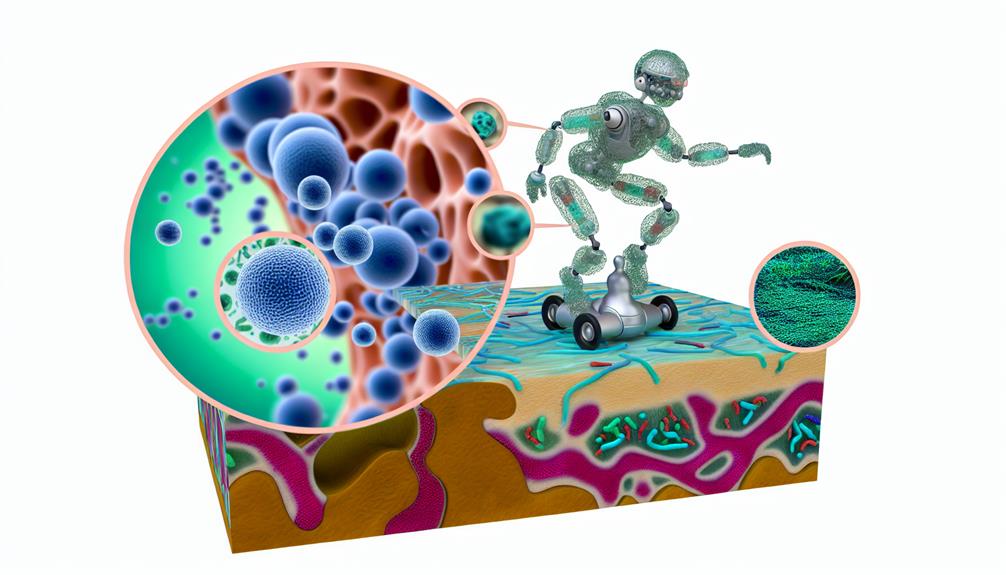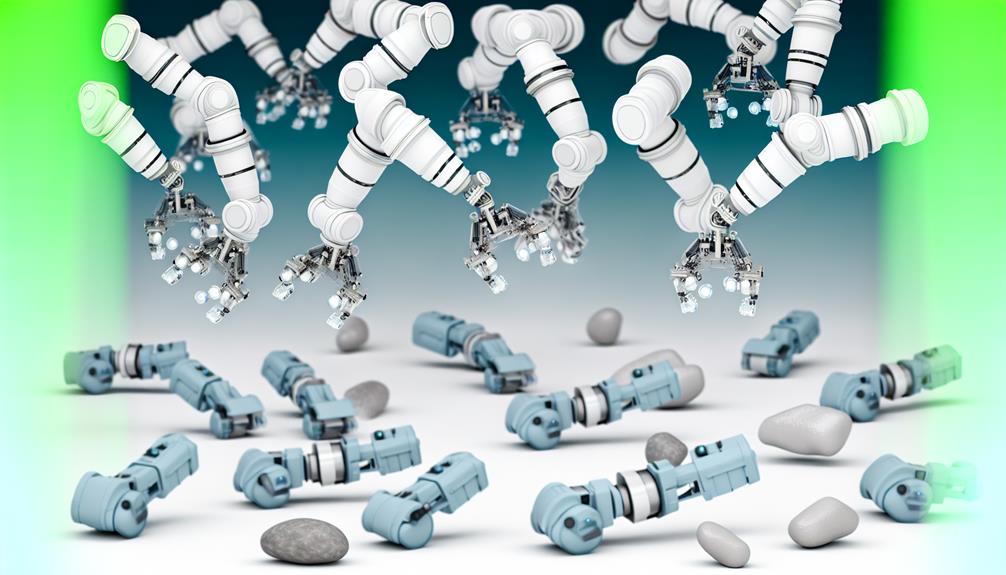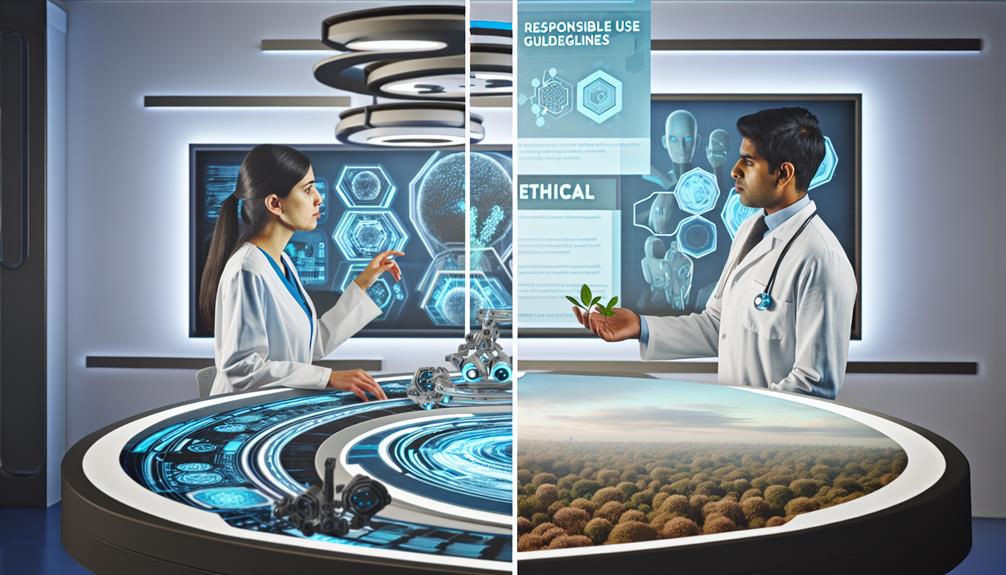The convergence of biology and robotics has yielded a remarkable advancement in the form of xenobots, living machines crafted from frog cells. Their potential to revolutionize the fields of medicine and environmental monitoring is a testament to the innovative capabilities of scientific research. With promising applications in targeted drug delivery, pollution remediation, and microsurgery, xenobots have captured the attention of experts and enthusiasts alike.
However, the ethical considerations and ecological impact of these living machines raise critical questions that demand careful consideration. As the field of xenobotics continues to progress, the profound implications and prospects of this technology are poised to reshape our understanding of living systems and their practical applications.
Yes, xenobots are living machines created from frog cells, designed for specific tasks. They are a new field in robotics, combining biology and engineering levels.
The Birth of Xenobots

In 2024, a team of scientists accomplished a groundbreaking feat in the field of robotics by creating the world’s first living robots, known as Xenobots, from frog cells. These tiny machines, with a simple body structure made of skin and heart muscle cells, can self-heal, self-replicate, move in a coordinated manner, and even carry small objects. Xenobots have potential applications in targeted drug delivery, pollution cleanup, and microsurgery, revolutionizing the fields of medicine and environmental monitoring.
However, ethical implications arise concerning the potential misuse of these living machines and their impact on ecosystems if released into the environment. As research and development continue, future advancements may involve incorporating different cell types into Xenobots and exploring their potential for environmental monitoring. Establishing guidelines for responsible use is crucial as the field of xenobotics rapidly advances.
Potential Medical Applications
Demonstrating remarkable potential, Xenobots offer promising prospects in the realm of medical applications due to their unique capabilities and adaptability. These living machines show great promise for targeted drug delivery, as their ability to navigate through the body and carry small objects could revolutionize the way medicines are delivered to specific cells or tissues. Moreover, Xenobots hold significant potential in microsurgery applications, where their precise movements and biocompatibility could enable minimally invasive procedures and tissue repair.
The self-healing and self-replication capabilities of Xenobots further enhance their appeal for medical use, opening doors for innovative approaches in regenerative medicine. As research in Xenobotics progresses, their impact on medical practices and treatments is anticipated to be groundbreaking, propelling advancements in drug delivery and microsurgery.
Environmental Cleanup Potential


With their potential to revolutionize medical applications, the adaptability and unique capabilities of Xenobots also present a promising prospect for environmental cleanup initiatives. These living machines show promise in the field of environmental monitoring and remediation due to their ability to navigate through complex environments and carry small objects. Xenobots can be engineered to detect and remove environmental pollutants, such as microplastics or contaminants in water systems. However, ethical considerations regarding their potential ecosystem impact must be carefully addressed to ensure responsible deployment.
As researchers continue to explore the environmental cleanup potential of Xenobots, future developments may offer innovative solutions for addressing environmental challenges while minimizing negative effects on ecosystems. This ongoing research signifies a potential expansion of Xenobots’ applications beyond the medical field, paving the way for their broader societal and environmental contributions.
Ethical Considerations
An examination of the ethical implications surrounding the creation and potential use of xenobots reveals complex considerations that demand careful evaluation and responsible decision-making. The creation of xenobots raises ethical concerns, particularly regarding their potential misuse. There are apprehensions about the impact on ecosystems if xenobots were released into the environment, as well as the ethical implications of using living cells for robotics.
The potential for unintended consequences and the need for regulatory guidelines to prevent misuse are critical aspects that require thorough consideration. Scientists and policymakers are actively working to establish ethical frameworks and guidelines for the responsible development and deployment of xenobots. Addressing these ethical implications is essential to ensure that the potential benefits of xenobotics in medicine and environmental monitoring are realized without compromising ethical standards.
Ongoing Research and Development


Continual exploration of novel methodologies and cellular compositions is propelling the ongoing research and development of xenobotics, with a focus on enhancing their functional capabilities and potential applications. Scientists are actively working to improve the functionality of xenobots, aiming to integrate different types of cells into their structure. This exploration holds promise for the advancement of xenobots into more complex and efficient living machines.
Moreover, ongoing research includes investigating the potential use of xenobots for environmental monitoring. This could revolutionize the field of environmental science by providing a new, living tool for monitoring and assessing environmental conditions. The rapid advancement of xenobotics is anticipated to lead to groundbreaking developments shortly, with the potential to significantly impact various industries, particularly in environmental monitoring and healthcare.
Self-Healing and Self-Replication
Xenobots demonstrate a remarkable ability to self-heal and self-replicate, distinguishing them as a pioneering advancement in the field of living machines. Through self-healing, these tiny robots can repair damage to their structure, ensuring prolonged functionality. Furthermore, their capacity for self-replication enables the potential for mass production, offering unprecedented opportunities for various applications.
However, the ethical implications surrounding the creation and use of xenobots raise concerns about responsible innovation and potential adverse impacts on ecosystems. As a result, regulatory measures and ethical frameworks are essential for guiding the development and deployment of xenobots. Establishing clear guidelines will be crucial in addressing these ethical concerns and ensuring the ethical and responsible use of this groundbreaking technology.
Moving forward, continued research and collaboration between scientists, policymakers, and ethicists will be essential in navigating the ethical considerations associated with xenobots.
Coordinated Movement and Object Carrying


Capable of coordinated movement and the transportation of small objects, xenobots exhibit a remarkable integration of living cells and robotic capabilities, showcasing their potential for diverse applications in various fields. In the industrial sector, xenobots hold promise for tasks such as microscale assembly and delivery within confined spaces, augmenting or even replacing traditional robotic systems.
Their ability to carry small objects could be harnessed for targeted drug delivery within the human body, presenting a revolutionary approach to medicine. However, the implications for robotics ethics are at the forefront, prompting discussions on the responsible use of xenobots and their potential impact on ecosystems. As research in xenobotics progresses, it is imperative to address these ethical concerns while exploring the significant potential industrial applications of these living machines.
Future Cell Incorporation
Expanding upon the potential industrial applications and ethical considerations of xenobots, the future incorporation of different types of cells into these living machines is a topic of ongoing research and exploration in the field of xenobotics. Cell engineering holds promise for enhancing xenobot functionality and diversifying its capabilities. By incorporating specialized cells, such as those with sensory or detoxification functions, xenobots could be tailored for environmental monitoring and pollution remediation.
This advancement may enable xenobots to detect and address environmental hazards with a high degree of precision. Moreover, the ability to integrate different cell types into xenobots opens avenues for targeted applications in medicine and industry. As research progresses, the potential of xenobots in environmental monitoring and remediation through cell incorporation is poised to drive significant advancements in the field of xenobotics.
Responsible Use Guidelines


The ethical use of living cells for robotics, particularly in the context of xenobots, necessitates the establishment of responsible guidelines to ensure the safe and conscientious deployment of these innovative machines. Addressing ethical implications is crucial in determining the potential impact of xenobots on ecosystems, thereby ensuring their responsible use. Concerns about the impact on ecosystems if xenobots were released into the environment must be thoroughly evaluated.
Furthermore, the ethical implications of using living cells for robotics are being debated by scientists and policymakers. Establishing guidelines for the responsible use of xenobots is essential to mitigate potential risks and ensure their safe integration into various fields. By addressing these concerns and establishing clear guidelines, the potential benefits of xenobots can be harnessed while minimizing any potential negative impacts on the environment and society.
Revolutionary Impact
A paradigm-shifting development in the field of robotics, Xenobots have the potential to fundamentally transform the landscape of medicine and environmental monitoring through their unique capabilities and functionalities. In the realm of regenerative medicine, the advancements brought about by Xenobots are revolutionary. These living machines offer the potential for targeted drug delivery, microsurgery, and even the ability to aid in cleaning up pollution. Their self-healing and self-replication abilities also hold implications for ecosystem monitoring, potentially revolutionizing environmental conservation efforts.
However, the release of Xenobots into the environment raises ethical concerns regarding their impact. With ongoing research and advancements, the responsible use of Xenobots is a crucial aspect that needs to be addressed. As the field of xenobotics continues to progress, it is expected to drive further innovation in both medical and environmental domains.
Frequently Asked Questions
Can Xenobots Be Used for Military Purposes or Warfare?
The potential military applications of xenobots raise ethical concerns about their use in warfare. As living machines, their deployment could have far-reaching implications for both combat and the environment, prompting a need for careful consideration and regulation.
What Are the Potential Long-Term Effects of Releasing Xenobots Into the Environment?
Releasing xenobots into the environment poses potential long-term consequences. Environmental impact assessments are crucial to understanding how these living machines may interact with ecosystems. Research must address concerns about unintended effects on biodiversity and ecosystem stability.
How Do Xenobots Compare to Traditional Robots in Terms of Efficiency and Functionality?
Xenobots, utilizing living cells, show promise in efficiency and functionality compared to traditional robots. Their self-healing, self-replicating abilities and potential for targeted drug delivery and environmental cleanup set them apart, driving ongoing research.
Are There Any Potential Health Risks Associated With Using Xenobots in Medicine?
While xenobots show promise in targeted drug delivery and microsurgery, potential health risks must be carefully considered. Regulatory concerns and safety protocols are crucial to ensure responsible medical applications without adverse effects on patients.
What Are the Ethical Implications of Using Xenobots for Regenerative Medicine and Organ Transplantation?
Ethical implications of using xenobots for regenerative medicine and organ transplantation raise public perception concerns. The use of living cells in robotics prompts ethical debates. Establishing responsible guidelines is crucial to address potential misuse and environmental impact.
Conclusion
In conclusion, the emergence of xenobots represents a groundbreaking advancement at the intersection of biology and robotics. With their potential for targeted drug delivery, pollution remediation, and microsurgery, xenobots hold promise for revolutionizing medicine and environmental monitoring. However, ethical considerations and ecological impact must be carefully addressed.
As research in xenobotics continues to advance, the field is poised for rapid growth and potential societal impact. How might the responsible use of xenobots shape the future of medicine and environmental stewardship?


